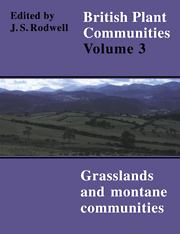Book contents
- Frontmatter
- Contents
- List of Figures
- Preface and Acknowledgements
- Preamble
- Mesotrophic Grasslands
- Community Descriptions
- Calcicolous Grasslands
- Community Descriptions
- Calcifugous Grasslands and Montane Communities
- Community Descriptions
- Index of Synonyms to Grasslands and Montane Communities
- Index of Species in Grasslands and Montane Communities
- Bibliography
CG6 - Avenulapubescens Grassland
Published online by Cambridge University Press: 04 July 2020
- Frontmatter
- Contents
- List of Figures
- Preface and Acknowledgements
- Preamble
- Mesotrophic Grasslands
- Community Descriptions
- Calcicolous Grasslands
- Community Descriptions
- Calcifugous Grasslands and Montane Communities
- Community Descriptions
- Index of Synonyms to Grasslands and Montane Communities
- Index of Species in Grasslands and Montane Communities
- Bibliography
Summary
Synonymy
Chalk grassland auct. angl. p.p.; Helictotricho-Caricetum flaccae, Sub-association of Holcus lanatus & Trifolium repens Shimwell 1968ap.p.; Swyncombe Down grasslands Smith et al. 1971 p.p.; Chalk grassland, Helictotrichon pubescens type Duffey et al. 1974; Festuca rubralHelictotrichon pratenselH. pubescens tussock grassland Wells et al. 1976; Festuca rubra grassland Smith 1980; Helictotrichon grasslands Smith 1980 p.p.
Constant species
Avenula pratensis, A. pubescens, Festuca rubra, Lotus corniculatus, Taraxacum officinale agg., Pseudoscleropodium purum.
Physiognomy
The vegetation here is usually dominated by various mixtures of Festuca rubra (occasionally with a little F. ovina) and generally smaller amounts of Avenulapubescens and A. pratensis. The abundance of these grasses gives the swards a markedly rank character and their intravaginal growth can produce a pronounced hummocky structure. The only other grass which is at all frequent throughout is Koeleria macrantha, though it is rarely present in large amounts. There is occasionally some Agrostis stolonifera and Anthoxanthum odoratum; Arrhenatherum elatius occurs rarely, though it can be locally prominent.
In this grassy ground, frequent associates are relatively few and mostly hemicryptophytes which can produce larger rosettes or sprawls of shoots. Taraxacum officinale agg. and Lotus corniculatus are constant and there are frequently scattered plants of Carex flacca, Leontodon hispidus, Plantago lanceolata, Sanguisorba minor and Cirsium acaule. There are sparse records for a variety of species of calcicolous swards and weedy mesotrophic grasslands. Chamaephytes and smaller pauciennials are characteristically few and infrequent.
Bryophytes, too, are uncommon apart from the robust pleurocarp Pseudoscleropodium purum which can be abundant.
Sub-communities
Dactylis glomerata-Briza media sub-community: Helictotricho-Caricetum flaccae, Sub-association of Holcus lanatus & Trifolium repens Shim well 1968a p.p. Although the three constant grasses of the community, and especially F. rubra, can be very abundant here, they are less uniformly dominant and the swards have a distinctly patchy appearance which is often accentuated by the local prominence of Dactylis glomerata, Holcus lanatus, Briza media and Danthonia decumbens.
Among the preferential associates, some calcicoles are more frequent in this sub-community, notably Linum catharticum, Sanguisorba minor, Carex flacca and Helianthemum nummularium. Other distinctive species here include Succisapratensis, Cirsiumpalustre, Agrimonia eupatoria, Centaurea nigra, Primula veris and Listera ovata.
- Type
- Chapter
- Information
- British Plant Communities , pp. 188 - 193Publisher: Cambridge University PressPrint publication year: 1992

